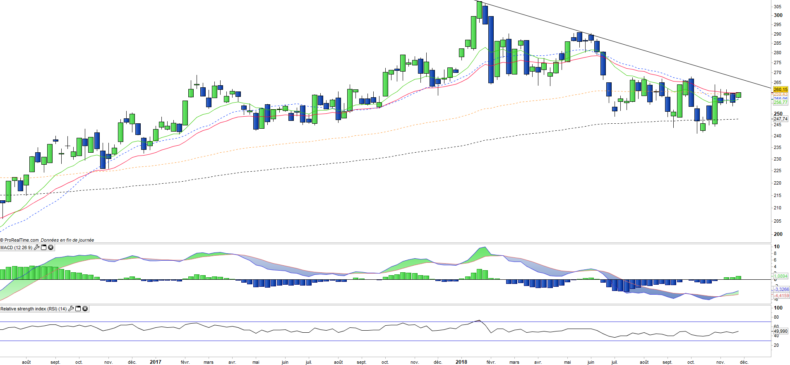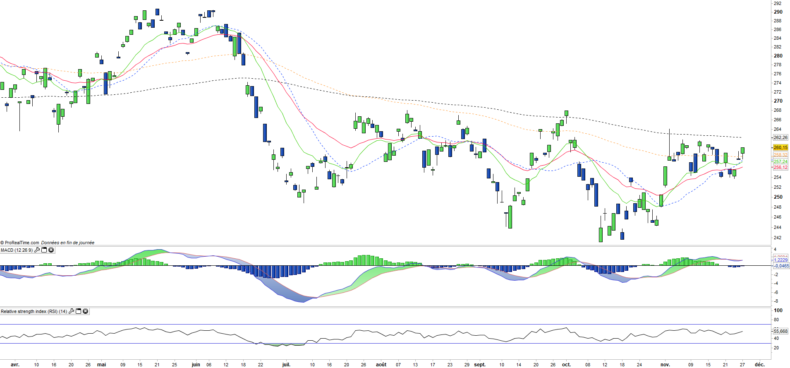Amundi ETF China (CC1) - 28/11/2018
Short Term strategy: Positive (60%) / Trend +
Long Term strategy: Positive (60%) / Trend +
Characteristics of the ETF
The CC1 ETF (Amundi) created in 03/2009 is listed in EURO on Euronext and replicates the MSCI China-H net dividends reinvested index ("net return"), which is composed of the main Chinese stocks listed in Hong Kong and composed for 2/3 of financial values. These shares are subject to Chinese regulation but denominated in Hong Kong dollar (HKD). Chinese H shares, unlike A shares, are available to non-resident investors in China. The target for maximum tracking error between changes in the net asset value of the Fund and that of the MSCI China H Index is 2%. This tracker presents a currency risk linked to the exposure of the MSCI China H Index, resulting from the evolution of the reference currency, the Hong Kong dollar (HKD).
The fee of this ETF is 0.55% for an AUM of 153M €. The replication method is synthetic (via swaps).
Alternative ETFs: CSIA (Lyxor in Euro), FXI (iShares in USD)
Latest developments
After a rise of 13.6% in 2017, CC1 is down -3.7% in 2018, which is mainly related to the credit restrictions decided by the Chinese authorities as well as the US-China trade war, which is escalating and has led to a rise in tariffs on $ 250 billion of Chinese exports to the US and which could extend up to $ 500 billion.
The last statements (tweet) of D.Trump ahead of the G20 summit next weekend have showered the hopes of a deal, however at the same time any progress will be seen as positive and as a success. By lowering investor expectations, D.Trump may be creating conditions for a stock market rally next week. The US and China are fundamentally interested in finding a quick compromise in order to avoid a recession in the coming months and while the US elections will take place in 2020. The basis for an agreement could be established soon and result in a pause in the trade war, just like what happened with Europe on the automotive sector.
Index & components
The equities that make up the MSCI China-H Index come from the universe of the most important stocks in the Chinese market.
The MSCI China-H Index is composed of 68 constituents, so it is relatively diversified. The financial sector (banks and insurance companies), however, accounts for about 68% of the capitalization while the China Construction Bank accounts for 16% of the index.
China is the world's second largest economy behind the US with a GDP of about $ 13600bn in 2017, the world's largest exporter with the world's largest foreign exchange reserves.
The global recession of 2009 interrupted China's continued growth momentum, and the limits of its export-oriented growth model emerged. As a result of the global economic downturn and declining trade, Chinese growth decelerated to below 7% in 2015, its lowest level in 25 years. However, in 2017, growth reached 6.9% of GDP, an improvement over 2016 (6.7%). State-owned enterprise debt accounts for 145% of GDP while private sector debt accounts for more than 200% of GDP. In addition, the quality of bank assets has deteriorated for several years and this trend is probably underestimated because of the importance of the shadow banking.
Many challenges remain linked to the problem of an aging population, the lack of openness of the political system, the competitiveness of an economy dependent on high investment expenditure and the expansion of credit. The manufacturing and construction sectors contribute nearly half of China's GDP, but the country is increasingly relying on services and domestic consumption.
China has set a growth target for 2018 of around 6.5%, which means a gradual soft landing linked to the new growth model, more based on quality, corresponding to an upscaling of industry and services, but also focused on reducing the current major imbalances (too high debt, overcapacity in industry and real estate). China no longer seems to be in the race for growth, but in search of a more balanced and sustainable model based on the upscaling of its industry through technology and the expansion of services and domestic consumption.
China faces geopolitical problems with most of its neighbors (India, Japan ...) and especially in the China Sea, because of its plans for territorial expansion that could lead to military confrontations. Its confrontation with the USA, at the commercial level, could be amplified under the background of the Korean crisis.
Weekly data
Weekly chart analysis shows a bullish reversal attempt after a rebound on the EMA200 and a current overflow of the EMA100 and EMA26 which are almost at the same level. The oscillators have turned upward and reinforce the technical profile of the index. There remains the bearish line to cross to validate the bullish reversal.
Daily data
The analysis of the daily charts shows that the short-term reversal is already well underway with the overtaking of the short term moving averages and the EMA100, and the upcoming attack of the EMA200 whose bullish crossing will confirm the ongoing recovery. The prices arrive in a zone of resistance at around 265 €, which remains a pivotal level for a swing in uptrend.
ETF Objective
CC1 is a UCITS ETF, listed in EUR, which seeks to replicate the MSCI China H index (68 chinese companies)
Characteristics
| Inception date | 03/03/2009 |
| Expense ratio | 0,55% |
| Issuer | Amundi |
| Benchmark |
MSCI China H
|
| Code/Ticker | CC1 |
| ISIN | FR0010713784 |
| UCITS | Yes |
| EU-SD Status | Out of scope |
| Currency | Euro |
| Exchange | Euronext Paris |
| Assets Under Management | 153 M€ |
| PEA (France) | Yes |
| SRD (France) | Yes |
| Currency risk | Yes |
| Number of Holdings | 68 |
| Risk | 4/5 |
Country Breakdown
| China | 100% |
Sector Breakdown
| Financials | 66% |
| Energy | 10% |
| Industrials | 7% |
| Materials | 4% |
| Consumer discretionary | 3% |
| Telecom services | 3% |
| Health Care | 2% |
| Others | 5% |
Top Ten Holdings
| China Construct Bank | 16% |
| ICBC | 10% |
| Ping an Assurance | 10% |
| Bank of China | 7% |
| China Petroleum Chem | 5% |
| Petrochina Co | 3% |
| China Life Insurance | 3% |
| Agricult BK China | 3% |
| China Merchants Bk | 3% |
| China Pacific Insur | 2% |


